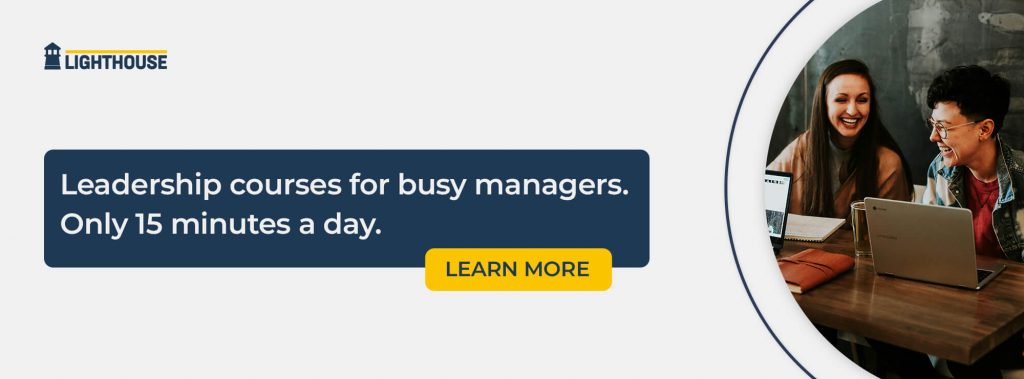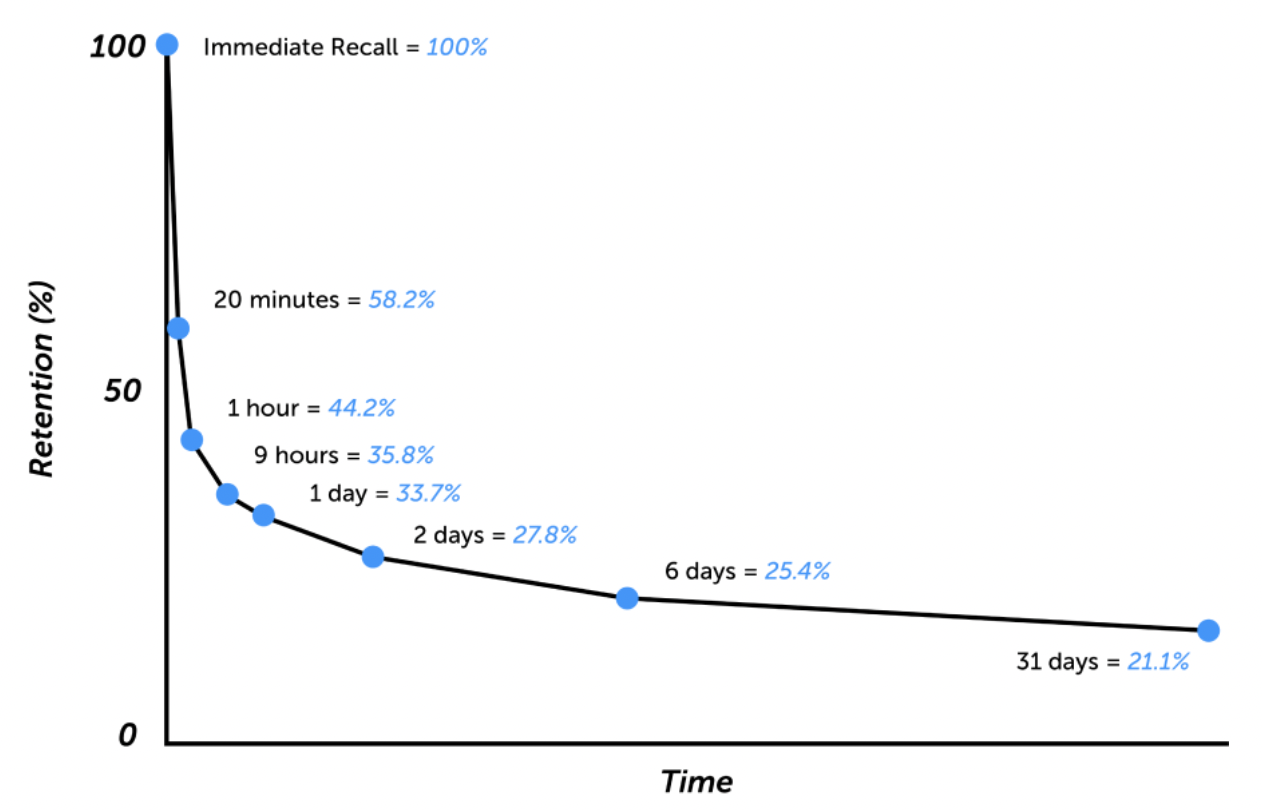“Attention: Upcoming training for you next week”
Does that subject line give you chills, make you groan, or are you excited by it?
If you’re like a lot of managers we have spoken to over the years, it’s probably a mix of disappointment and a feeling of resignation to go through the motions.
No matter how compelling the speaker’s pitch may be, workplace training sessions often leave managers feeling cheated; they lose valuable time to get work done, and they don’t feel like they learned things they can apply to their team.
This is reinforced by a report by McKinsey that found over 75% of its survey respondents believed training doesn’t have any positive impact for them. Even worse, the closer you are to the front line, the more likely you are to be disappointed:
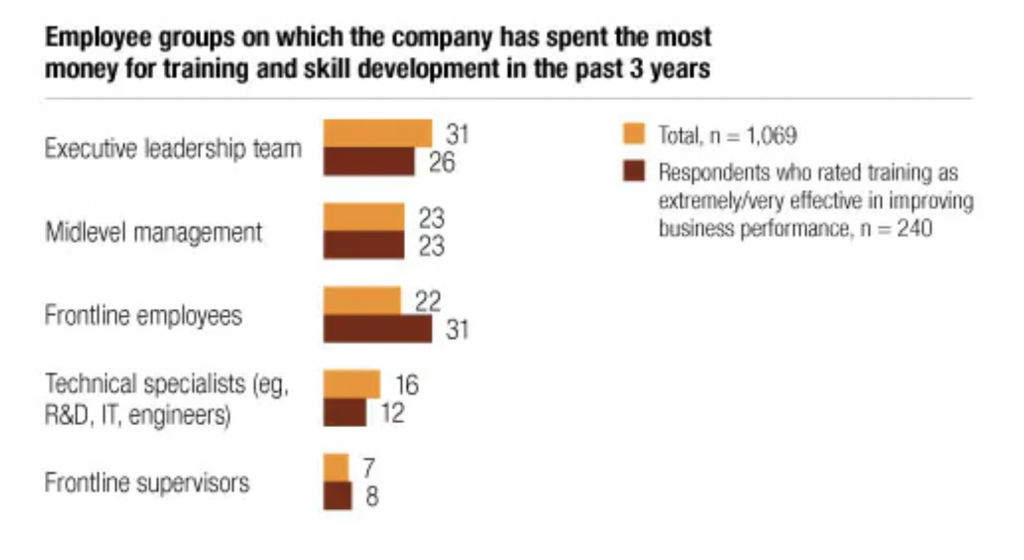
Even the best in executive leadership, who receive the lion’s share of training, still have a minority of them who believe their training has a great impact on their business.
With all the money, hype, and most importantly, time spent on this, you have to be thinking the same thing we did: Why!?!?

How management training misses the mark
When we asked managers like you why they dislike the training they receive, managers have told us they found it:
- Distracting: It took away from time to get your day to day work done, all while your emails and notifications piled up.
- Irrelevant: It had little to do with the real challenges you face every day, along with examples that you couldn’t relate to.
- Unstructured: You had to process a lot of new information, and figure out how you can apply it to your work situation on your own.
Not surprisingly, a few weeks later, you will have forgotten most of what you sat through.
Use it or lose it…
All too often after training, we go back to our desks and go right back to our work; it’s backed up during your day or week long training session after all.
When that happens, it’s extremely easy to keep doing things the way we have always done them. Change is hard, and it’s so tempting to say you’ll revisit your notes from the training, “later.”
Unfortunately, that later, never comes; we never do get around to really thinking about that training program, and never find the time to figure out how to apply what we learned to our work with our team.
What’s a leader to do?!?
Despite all this, everyone in this process tends to have the best of intentions:
- HR wanted to fix a problem they identified, or an executive asked them to focus on.
- The trainer was motivated to create their programming to teach you and make a difference.
- You wanted to learn something that would make you better. (You’re the kind of person that reads management blogs, after all)
In this post, we'll explore the research and science behind why traditional management training is set up to fail, and talk about an alternative way for leveling up your team effectively: microlearning.
Table of Contents - Corporate microlearning benefits and why it works
- The Ebbinghaus curve: How and why we forget
- Microlearning benefits #1: Remember More of What You Learn for Longer
- Microlearning benefits #2: Lean into how we perform best
- Microlearning benefits #3: It’s much less disruptive
- How you can start microlearning today
The 3 Key Benefits of Bite Sized Learning in Management Training + the Science of Why it Works Better.
Before we dive into the benefits of microlearning, we need to set a foundation for you. While you may not realize it, you're leaving a lot of learning and opportunity with traditional training approaches with big name speakers and all day classroom settings.
And it all starts back over 100 years ago...

The Ebbinghaus insight: How and why we forget what we learn
Ever heard of the Ebbinghaus forgetting curve?
It’s a theory on memory and learning developed in the late 19th century by a German psychologist named Hermann Ebbinghaus. According to his work, if you try to learn everything all in one big session, you will rather quickly forget the majority of what you studied.
If you ever crammed for an exam, you’ve likely experienced this feeling; at first (and just in time for the test) you remember everything, but because you crammed your studying into such a tight period of time, a few weeks later you’ve forgotten almost all of it.
This is crystallized in this chart from Ebbinghaus showing that we forget nearly 80% of what we learned within a month of a crammed session:
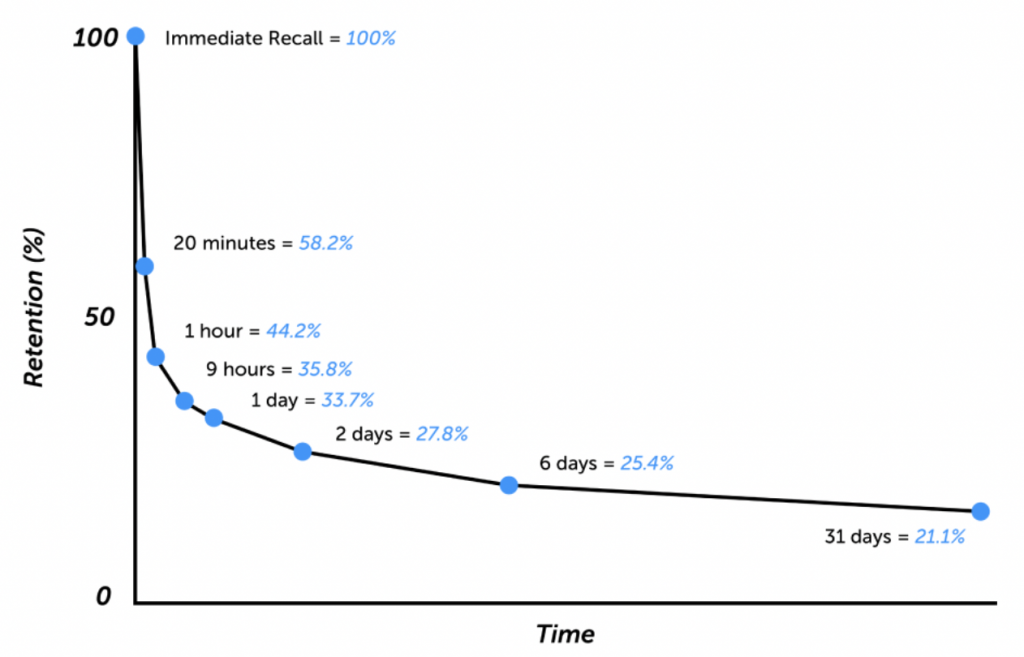
The Ebbinghaus curve has since been used as a foundation for research about how people remember, retain and forget information. The theory has also been a major part of reevaluating the way we study, both in schools and at work to help people learn in ways that last.
Why we forget.
Ebbinghaus also discovered some root causes for why we forget. While it’s natural to forget things after first hearing about them, he found that there are some things you can do to improve your memory and recall.
Without taking enough breaks between study sessions, you’re likely to forget what you just learned much more quickly, Ebbinghaus’s research has shown us. The same happens with overly long lectures or training sessions. When you’re not giving your brain the necessary time to digest new information properly, you’ll be losing it much quicker.
What is bite sized learning? (aka - microlearning benefits)
Bite sized learning focuses on studying in small portions. Rather than cramming things in all at once, you space out the small pieces over time, which can improve retention and understanding of what you’re learning.
Specifically, the biggest benefits of bite-sized, microlearning are:
- Improved retention – recall can stay as high as 90% even multiple days after the last bit of learning
- Increased engagement - microlessons’ size and formatting make it more approachable, because it’s less daunting and a smaller commitment.
- Increased productivity – even when you add up all the bite-size learning sessions, it can still net out to a time savings versus traditional training by as much as 90%.
Okay, that all sounds great, but how does microlearning do that? And what’s this research you’re alluding to that supports this?
Let’s dive in…
Microlearning Benefits #1: Remember More of What You Learn for Longer
No matter how interesting your training material might be, if you present it to people all in one go, they’re just not going to retain it for very long. As Ebbinghaus’s curve reminds us, being presented or studying information all at once is soon forgotten.
And it’s not just Ebbinghaus that shows us this is true.
In 1967, researcher Geoffrey Keppel had college students study in two different formats:
- The first group studied the material 8 times all on the same day
- The second group studied the material 2 times a day for 4 days
This meant that both groups studied the same amount of time, yet the results of what they remembered was quite different:
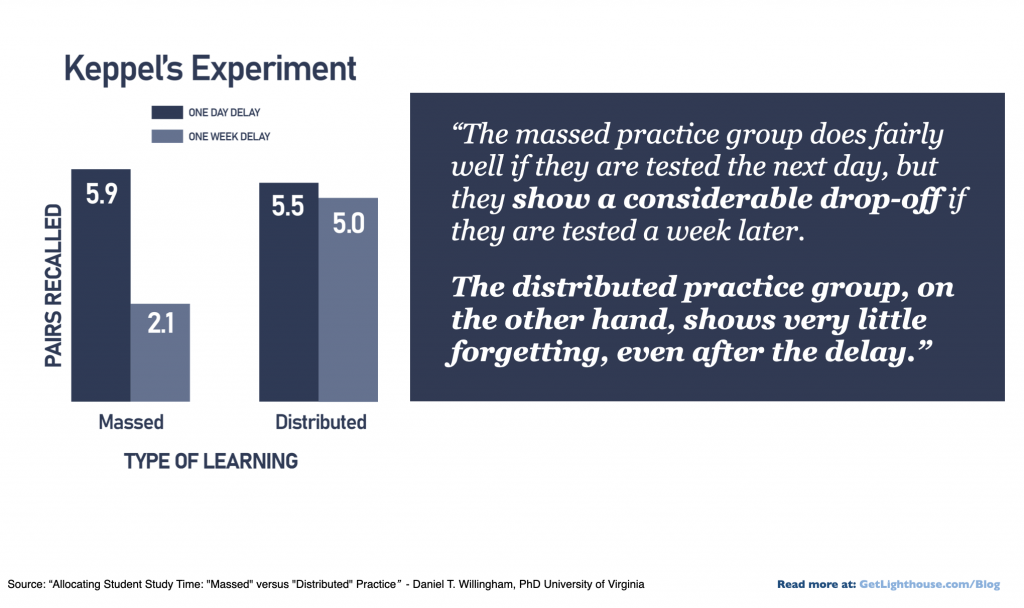
As the chart above shows, the single day studying group scored the highest of any of the tests when tested the day after they finished studying. Yet, just a week later, they had forgotten nearly 2/3rds of what they had previously known.
Meanwhile, the spaced learning group showed remarkable consistency in scoring well a day after, and still remembering over 90% as much a week after.
Keppel & Ebbinghaus are in good company.
Okay, so some guy in the 1800s and a professor testing students in a quick exam found that cramming leads to forgetting. Those are just isolated incidents in a research setting, right?
Wrong.
As it turns out, a meta-analysis of studies by Sean H K Kang at the University of Melbourne found the same:
“Hundreds of studies in cognitive and educational psychology have demonstrated that spacing out repeated encounters with the material over time produces superior long-term learning, compared with repetitions that are massed together.
…Spaced review or practice enhances diverse forms of learning, including memory, problem solving, and generalization to new situations. Spaced practice is a feasible and cost-effective way to improve the effectiveness and efficiency of learning, and has tremendous potential to improve educational outcomes.”
If you want to learn material, and really be able to apply it, then spacing out when you review it makes a big, positive difference.
How much spacing is enough spacing?
Now, you may be wondering how to space out your learning to make it stick when you learn something at work.
We were curious, too, and it turns out that Kang’s meta-analysis had the answer to that as well:
“A large experiment examined 10 different lags (the spacing gap between initial learning and retrieval practice review ranged from 0 to 105 days) and four different retention intervals (the final test was administered either 7, 35, 70, or 350 days after the review session).
[Retention] was highest when the lag was about 10% to 20% of the tested retention interval.
In other words, there is no fixed optimal lag—It depends on the targeted retention interval. If you want to maximize performance on a test about 1 week away, then a lag of about 1 day would be optimal; but if you want to retain information for 1 year, then a lag of about 2 months would be ideal.”
Given that anything we learn at work we probably want to learn for the long haul, then the longer lag seems to apply here.
That means that rather than receiving all your training in one day, or a multi-day series, you’ll want to space out what you learn; spreading out over multiple weeks or even months is what the study found led to retention a year later.

Microlearning Benefits #2: Lean into how we perform best
Learning effectively is not just about how much you remember days or weeks later. It also is about meeting everyone on a level where they tend to learn best.
And it turns out that microlearning in bite size pieces also does that better than traditional, intensive teaching methods as well.
It’s talked about regularly and is worth remembering in this context: attention spans are getting shorter. Between all the notifications and messages that drive our interrupt driven society, to the challenges of those with ADD or ADHD, focusing for long periods of time is hard.
For example, a study at Surrey Business School revealed a simple, and stark fact:
“Traditional learners remembered 78% of the material presented in the first half of an hour-long lecture, but by the second-half, they only remembered 22%.
This suggests that shorter lectures are more effective for student recall.”
That’s quite the drop! In the first 30 minutes, you could reasonably expect to remember 3 out of 4 facts or ideas you heard from a teacher or trainer and yet you wouldn’t even remember 1 out of 4 of those same facts in minutes 31 to 60 of a session.
Create natural breaks!
With that in mind, it’s not surprising that the popular productivity system known as the Pomodoro Technique traditionally focuses on 25 minute work sessions followed by a short break.
Similarly building in natural breaks to your training can help as authors of one study on microlearning’s benefits wrote:
“Students can finish a quick experience, grasp the key concept, and take a break. This method gives time for the learned material to be processed and indexed from short-term to long-term memory.”
This was reinforced by Annie Murphy Paul in a piece that she wrote for the New York Times in September 2011, where she wrote:
“Spaced repetition produces impressive results. Eighth-grade history students who relied on a spaced approach to learning had nearly double the retention rate of students who studied the same material in a consolidated unit, reported researchers from the University of California-San Diego in 2007
…The reason the method works so well goes back to the brain: when we first acquire memories, they are volatile, subject to change or likely to disappear. Exposing ourselves to information repeatedly over time fixes it more permanently in our minds, by strengthening the representation of the information that is embedded in our neural networks.”
There is only so much we can absorb before learning slows or stops entirely. Build in breaks, whether in between sessions or to spread out your learning across multiple days to make what you're trying to learn or teach stick.

Microlearning Benefits #3: It’s much less disruptive
In 2020, the average employee spent around 35 hours in training yearly – that’s nearly a full week worth of work! But is that time paying dividends? Is it working?
If you and your managers are forgetting most of what they’re being taught, and they’re not sure how to put what they learn into practice, is that a good investment of company money or your time?
Looks can be deceiving
One of the biggest tricks in all of this is those great, inspiring speakers and trainers brought into your company can *seem like* they’re a big hit. They get great scores after and can leave people feeling pumped up.
But has anything changed?
At Harvard University, they put this to the test. They had some students participate in a lecture with a well-regarded professor, while others learned in a more active, collaborative, and hands-on way.
What they found was fascinating, and a bit surprising:

While the lectures scored higher on all of the emotional scoring right after like enjoyment, effectiveness of teaching, and what students *thought* they had learned, when they were actually tested, you can see there is a clear winner for the active learning approach.
What that means for your workplace
Leaving the lecture hall for a moment, we can see that the important lesson here is that more active approaches that create opportunities for bite size learning perform better on what really matters: what you and your people remember.
By breaking up your training into bite-size pieces and embracing microlearning, you can save your team a lot of time sitting through highly-rated, but low-impact training.
You also set you and your managers up for better focus; it’s much easier to ask a manager to put their phone away and pay full attention to learning when it’s a 20, 30, 60 minute event than to ask them to step away for a full day or longer.
And with teams under more pressure in today’s economy and tight budgets, it’s important that every minute is time well spent. That means leaning into the benefits of corporate microlearning to both make every investment in training have a bigger impact, and freeing up more time for you and your managers to focus on their key teams and tasks.
Ultimately, keeping your management training short and to the point gives managers room to do what really matters: support their team and help them be great.
Change the way you learn and train your managers with bite sized learning
As you can see, there’s a lot to gain by embracing microlearning benefits in how you and your managers are trained.
By breaking what you need to teach or learn into smaller pieces, and then spreading that material out over time, you ensure:
- More of what’s taught is remembered long term
- Less fatigue occurs getting in the way of learning and draining you and your managers
- The full focus of you and your managers is brought because it’s a smaller ask each time you’re brought together to learn.
Take that material, the book, or the talks you have and think about how you can break them up. Look for opportunities for pomodoro-style breaks, and where you can space the learning out over time.
This is your chance to shift from lecture style learning to the more results-driven active learning. Be creative and you can have a great impact.
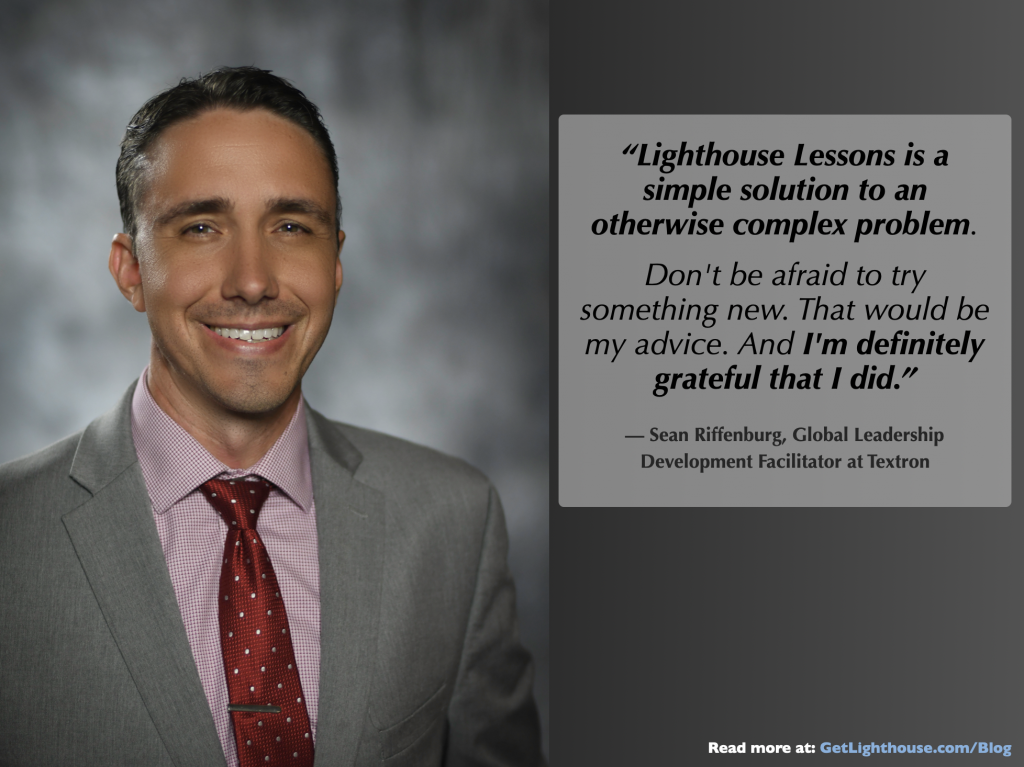
Lighthouse Lessons can help you. Microlearning benefits built from the ground up.
Don’t have the time, or ability, to break up your training into microlearning that really works?
Prefer a system built from the ground up for this?
We’ve got you covered.
Since 2018, we’ve been developing and improving our Lighthouse Lessons courses to take advantage of spaced learning, microlearning, and active learning approaches to bring bite-size, highly actionable programs to make you and your managers better leaders.
Each program contains:
- 10-12 highly actionable lessons focused on 1 key leadership theme like coaching, servant leadership, or motivation
- Weekly lessons that take ~15-20 minutes to read and act on (ideal for even busy managers)
- One simple action each week for managers to take with their team to put into practice what they learn
- Group discussion agendas so your managers can meet together to talk about the lessons, build bonds, and practice more active learning
Each of these aspects of our programs was built with the benefits of microlearning in mind. They're built to answer the question, "how can I train my managers without spending a lot of time myself or asking too much time of them?"
Want to see how Lighthouse Lessons can help you and your team?
See our many course offerings and more information here, or if you’re actively looking for something now, sign up for a free informational call to get your questions answered and learn more here.
